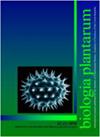杨树科AP2/ERF基因家族的鉴定及其对盐胁迫、脱落酸和赤霉素酸的响应
IF 0.9
4区 生物学
Q4 PLANT SCIENCES
引用次数: 0
摘要
胡杨属于杨柳科,生长在极端沙漠环境中。目前,杨柳科转录因子AP2/ERF基因家族的鉴定尚不多见,在盐胁迫和外源激素作用下,AP2/ERF基因家族在胡杨中的作用也未见报道。在本研究中,分别在胡杨、毛果杨、三角杨、紫苏和拟南芥中鉴定了197、210、231、192和147个AP2/ERF基因。通过序列比对和系统发育分析,将胡杨的197个AP2/ERF基因家族成员分为5个亚科,即AP2(35)、RAV(5)、ERF(96)、DREB(65)和Soloist(1)。此外,这些基因分布在19条染色体上。对胡杨AP2/ERF基因家族中10个基序的检测表明,motif-8和motif-9分别只出现在ERF亚家族和DREB亚家族中。转录组数据显示,在盐胁迫、脱落酸(ABA)和赤霉酸(GA3)处理下,PeAP2/ERF基因具有不同的表达模式,表明基因PeERF002、PeERF037、PeERF082、PeERFO90和PeAP2-14可能在盐胁迫和外源激素处理下发挥重要作用。本研究为PeAP2/ERF基因的功能研究提供了参考,也为提高胡杨耐盐性的育种策略奠定了基础本文章由计算机程序翻译,如有差异,请以英文原文为准。
Identification of AP2/ERF gene family of Salicaceae and their response to salt stress, abscisic acid, and gibberellic acid in Populus euphratica seeds
Populus euphratica belongs to Salicaceae family and grows in extreme desert environments. At present, the identification of the AP2/ERF gene family of transcription factors in Salicaceae is rare, and the role of the AP2/ERF gene family in P. euphratica under salt stress and exogenous hormones has not been reported. In this study, 197, 210, 231, 192, and 147 AP2/ERF genes were identified in P. euphratica , Populus trichocarpa , Populus deltoides , Salix sinopurpurea , and Arabidopsis thaliana , respectively. The 197 AP2/ERF gene family members of P. euphratica were divided into five subfamilies, namely, AP2 (35), RAV (5), ERF (96), DREB (65), and Soloist (1), by sequence alignment and phylogenetic analysis. In addition, these genes were scattered across 19 chromosomes. The detection of 10 motifs in the P. euphratica AP2/ERF gene family revealed that motif-8 and motif-9 only appeared in the ERF subfamily and DREB subfamily, respectively. Transcriptome data showed that PeAP2/ERF genes had different expression patterns under salt stress, abscisic acid (ABA) and gibberellic acid (GA 3 ) treatments, suggesting that the genes PeERF002 , PeERF037 , PeERF082 , PeERF090 , and PeAP2-14 may play important roles under salt stress and exogenous hormone treatments. This study provides a reference for the functional study of the PeAP2/ERF gene, and it also lays a foundation for the breeding strategy to improve the salt tolerance of P. euphratica
求助全文
通过发布文献求助,成功后即可免费获取论文全文。
去求助
来源期刊

Biologia Plantarum
生物-植物科学
CiteScore
2.80
自引率
0.00%
发文量
28
审稿时长
3.3 months
期刊介绍:
BIOLOGIA PLANTARUM is an international journal for experimental botany. It publishes original scientific papers and brief communications, reviews on specialized topics, and book reviews in plant physiology, plant biochemistry and biophysics, physiological anatomy, ecophysiology, genetics, molecular biology, cell biology, evolution, and pathophysiology. All papers should contribute substantially to the current level of plant science and combine originality with a potential general interest. The journal focuses on model and crop plants, as well as on under-investigated species.
 求助内容:
求助内容: 应助结果提醒方式:
应助结果提醒方式:


